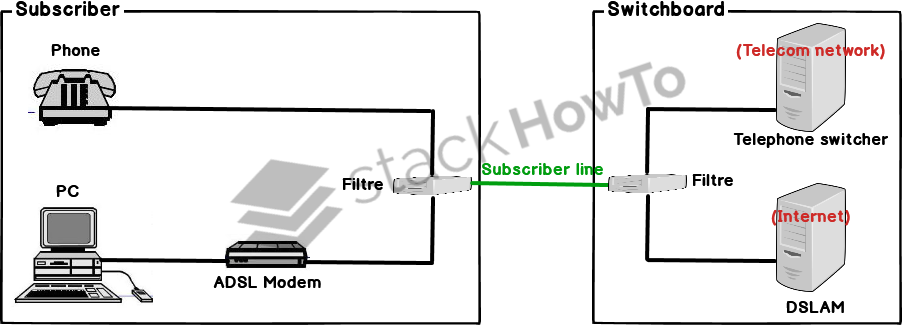What is ADSL?
In this tutorial, we are going to see What is ADSL?
The term DSL or xDSL stands for Digital Subscriber Line and groups together all the technologies set up for digital transport of information over a simple telephone connection line. The xDSL technologies are divided into two main families, the one using symmetrical transmission and the one using an asymmetrical transmission. These two families will be described later in this tutorial.
The term ADSL stands for Asymmetric Digital Subscriber Line. This system allows the coexistence on the same line a downstream high-speed channel, an upstream medium speed channel, and a telephony channel (called POTS in telecommunication which means: Plain Old Telephone Service).
The advantages of xDSL and ADSL technologies
The development of IT has brought new services requiring high transmission capacity. Fast Internet access, videoconferencing, network interconnection, teleworking, TV program distribution, etc. are part of these new multimedia services that the user wants to get at home or at the office.
Until now, the existing high-speed services (coaxial cable, optical fiber) were not well adapted to the real needs (too expensive cabling to be replaced by optical fiber or not very stable connection with coaxial cable). The idea of using twisted pair seems to be the best adapted since there are more than 800 million connections of this type in the world and it is enough to add a piece of equipment to the telephone operators’ offices as well as a small installation at the user’s home to be able to access ADSL.
Characteristics of ADSL technologies
The term DSL or xDSL can be classified into several groups: HDSL, SDSL, ADSL, RADSL, VDSL. Each of these groups has its own use and characteristics.
The differences between these technologies are to be differentiated by :
- The speed of transmission
- The maximum transmission distance
- The variation of flow between the upstream and the downstream
- The symmetrical or non-symmetrical nature of the link
The point-to-point connection is made via a telephone line between two pieces of equipment, firstly the NT (Network Termination) installed at the user’s home and secondly the LT (Line Termination) installed in the connection center.
ADSL equipment

The DSLAM:
The DSLAM (Digital Subscriber Line Access Multiplexer) is equipment generally installed in telephone operators’ offices and ensures the multiplexing of ATM flows towards the transport network.
This element does not only host ADSL cards but can also host different DSL services such as SDSL or HDSL by inserting the corresponding multiplexing cards. Each card supports several ADSL modems.
The elements grouped in the DSLAM are called ATU-C (ADSL Transceiver Unit, Central office end).
In fact, all the services available on the network (Internet, LAN-MAN-WAN, Teleshopping, MPEG Video) reach a DSLAM station via broadband and are then redistributed to the users.
The maintenance and configuration of the DSLAM and ADSL equipment are done remotely.
ADSL modems and routers
It is necessary that the modem decodes the data, which is called ATU-R (ADSL Transceiver Unit, Remote terminal end).
There are currently three types of modems depending on the user’s needs:
With 10/100 baseT interface, for PCs equipped with Ethernet card
ATMD 25 for PCs equipped with ATM card or to redistribute ADSL on an ATM network
With USB interface, for PCs equipped with USB interface
If the user wants to redistribute ADSL on his computer network, he will prefer using a router with an ADSL interface.





